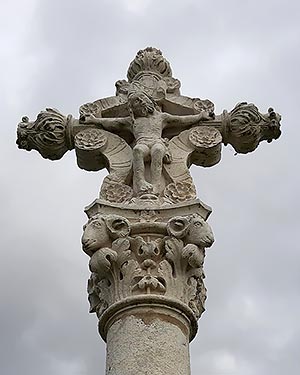Cultural heritage of Ororbia
The Wayside Cross
On the other side of the bridge stands a Renaissance Wayside Cross , whose promoter and date of construction are known thanks to the cartouche carved on the column: "ESTA CRUZ FIZO AZER DN IOAN DE ORORBIA BENEFICIADO AÑO 1540" (THIS CROSS FIZO AZER DN IOAN DE ORORBIA BENEFICIADO AÑO 1540). We do not know the reasons that led to its erection, but we cannot rule out that it is contemporary to the construction of the bridge. It presents the characteristic structure of this subject of works: staggered steps, of modern invoice ; pedestal, prismatic with two decreasing bodies; column, with its base, shaft and capital, in this case Corinthian with rams' heads in the corners; and the cross, with the figures of Christ crucified in the obverse and the Virgin with the Child in the reverse. The cross is embellished with pinecones in its three ends and with a decoration in the form of ces, which incorporate rosettes in the volutes. In those flanking the Virgin, these rosettes have been replaced by eagles. The figures are represented with a certain hieratism and rigidity. That of Christ, with the usual Adam's skull at the foot of the cross, sample a schematic Anatomy with horizontal arms without any flexion. On the other hand, Mary's expressive style has been pointed out. She appears on a mask, very frontal and wearing a wide tunic, while the Child is turned completely to her right, which contributes to break the frontality.
Among the stone crosses distributed throughout the geography of Navarre, the Ororbia cross is one of the most beautiful. test of this are the copies in the cemetery of Pamplona, Tiebas and the manor of Sarría, or its selection to be shown at the Ibero-American exhibition in Seville in 1929, where the Navarre pavilion exhibited the most representative manifestations of its artistic past. Among the variety of pieces gathered, only two term crosses were considered, the one from Etxalar and the one from Ororbia, which was to receive visitors outside the pavilion. Although it was disassembled and packed and is mentioned in the Catalog of the sample, it was never sent.
ALEGRÍA SUESCUN, D., Flour Mills of Ororbia. Historical-documental study, Concejo de Ororbia, 2015.
GUIJARRO SALVADOR, P., Ororbia: a thousand years of history, Concejo de Ororbia, Kybse, 2015.
MARTÍNEZ ÁLAVA, C. J., TARIFA CASTILLA, M.ª J. and LATORRE ZUBIRI, J., La iglesia de San Julián de Ororbia. History and restoration, Concejo de Ororbia. Foundation for the Conservation of the Historical Heritage of Navarre. Graftech Ibérica, 2014.
ZUBIAUR CARREÑO, F. J., "Catalog de miradas. La Navarra que fotografió Nicolás Ardanaz", in Ricardo Fernández Gracia (coord.), Pvlchrvm: Scripta varia in honorem M.ª Concepción García Gainza, Gobierno de Navarra. University of Navarra, 2011, pp. 838-846.
transcript del Asilo San José: file Contemporáneo de Navarra/Vivienda/1116846.











